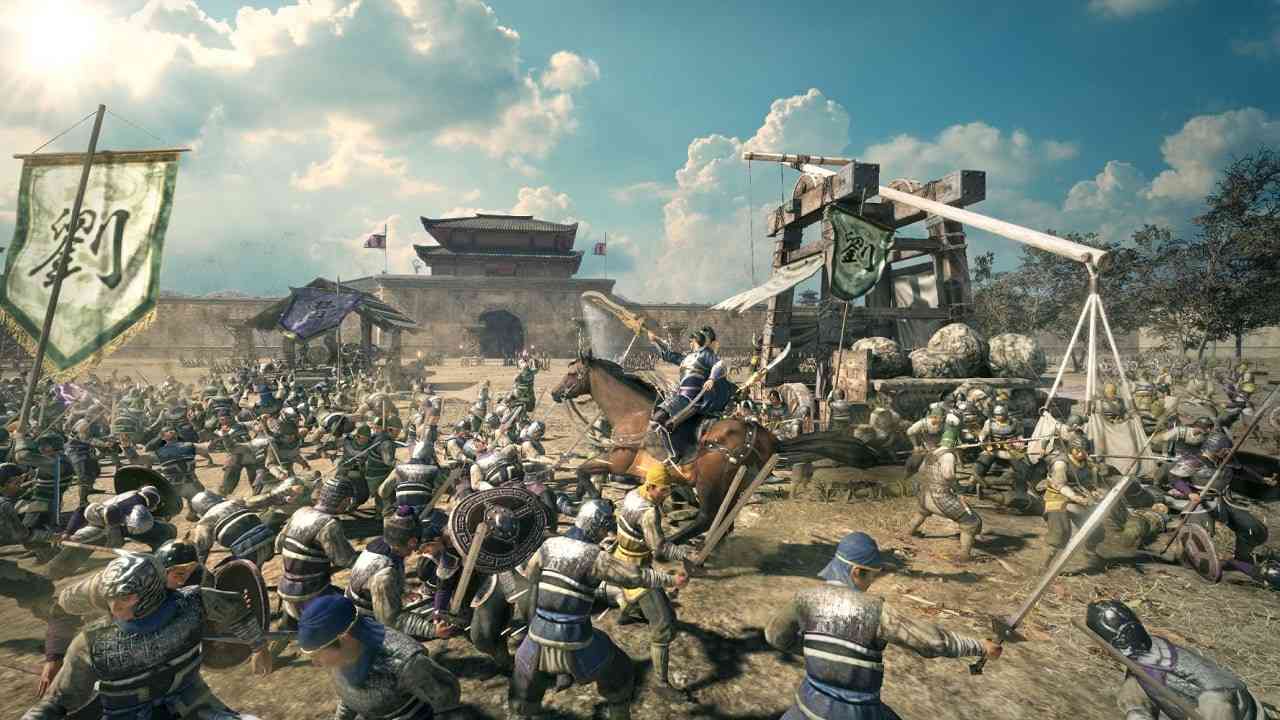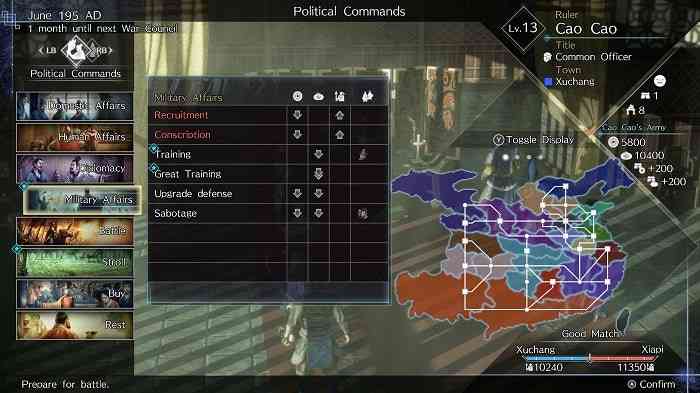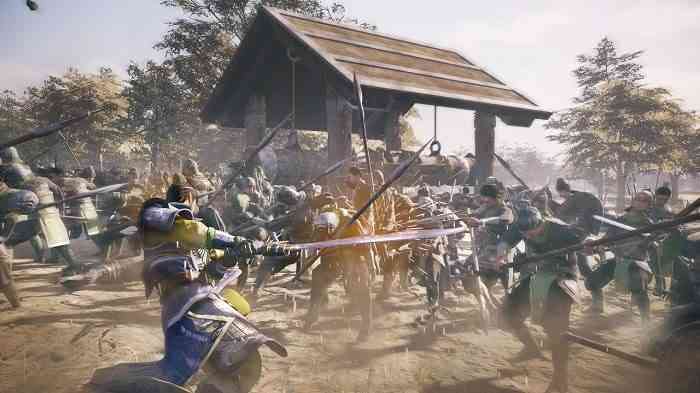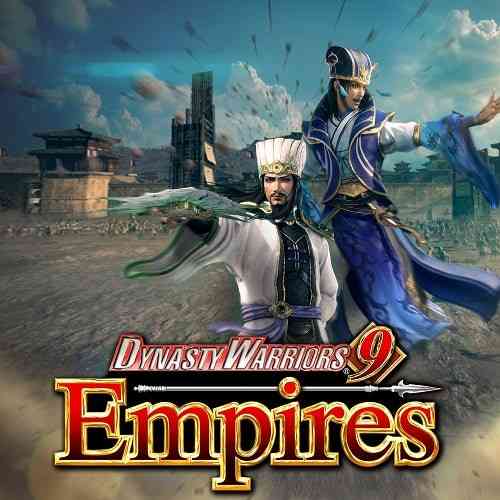The Empire Comes Back
Dynasty Warriors 9: Empires is part of an endless release cycle. As far back as Dynasty Warriors 4, Koei Tecmo has followed one mainline installment with a strategically oriented spin-off. The “Empires” name represents a branching lineage where players participate in the empire-building aspect of the three kingdoms romance. In many cases, it’s hard to discern which genre is better, the linear character progression or the branching kingdoms. Usually, it falls on the choice with more content.

Same World, Small Story
Despite the shoddy implementation of an open world in the last game, the Dynasty Warriors franchise has always maintained its allure of an expansive and dynamic cast of characters. Options are endless on the character selection screen, and it’s beautiful. Like previous installments of Empires, players can enter the fray through their era of choice. Start at the height of turmoil during the Yellow Turban Rebellion or the precipice of the three-kingdoms conflict. It is also your choice to begin your reign as the ruler of a splintered kingdom or a vagrant with a faction that will eventually battle its way to the seat of the emperor. Whatever the choice, it’s yours to make. If only there were more.
Changing Up the Formula
To highlight the wins and shortcomings in Dynasty Warriors 9: Empires, we must reference its predecessors. Until recently, the Dynasty Warriors franchise has followed a linear campaign formula. Select a kingdom, choose your character, watch the cut scenes, and cut through swathes of enemy minions on your path to cut through more swathes of enemy minions. The series entered a new era when it started implementing customization options. When the developers implemented a customizable campaign in Empires, the IP practically reached the zenith of replayability. Play-your-way mechanics improve with every edition since more characters are available. Unfortunately, a few mechanics have been stripped, such as Musou attack customization. Worse, the vast sandbox of the previous installment serves no purpose other than to stroll and share shallow conversations. If the open world didn’t sell you in Dynasty Warriors 9, it won’t now.

Empires’ virtue is that it allows the player to play their way. The bread and butter of Dynasty Warriors is the characters and hack and slash onslaughts. That doesn’t change here. In this case, however, dimensions shift since Empire management all but replace the open-world free roam. Koei Tecmo implemented better player incentives beyond looking forward to the next cutscene. Arguably, however, the only thing worse than arbitrary questlines, depending on who you ask, is no questlines. Empire management breaks up the monotony of moving from one battlefield to the next, yet Koei Tecmo stopped short of a worthwhile campaign when they stripped the game of quests. As a result, Conquest Mode is a loose collection of conflicts loosely tied together by shallow interactions. The lack of an overarching narrative limits the potential of the only available mode.
Empire Management
Away from the battlefield, we reach the simulation in Dynasty Warriors 9: Empires. Little has changed regarding the user interface, but there’s almost too much to do. For starters, every leader must set a policy. Policies directly affect income, rations, troop movement, and relationships with characters and other kingdoms. One action costs one month in what amounts to turn-based management. Fortunately, the initiative of your officers can compensate for leader limitations. Limitations make sense. A system of checks and balances assures that no faction can quickly consolidate their humble province into a full-fledged empire, and no empire succeeds without battlefield prowess. To some, it may seem like a slow burn. On the ground floor, the repetitive gameplay is noticeable. Luckily, the conflicts eventually escalate into a worthwhile payoff.

Progression is rewarding enough because it opens more doors. As previously mentioned, the character roster is a huge draw for the franchise. While copies of character abilities do show up, the replayability of the campaign persists. If you’re a ruler, Empires allows you to select whichever character you desire at the onset of battle, provided they’re in your faction and the area. Alternatives eliminate the need to create multiple save files (which you can still do). Better yet, the opportunity to play as different characters (potentially all of them) in the same campaign wipes away much of the monotony when fighting back-to-back battles. Couple that with the shifting dynamics of managing a kingdom, and the gameplay starts to shine.
Stacked Systems
The incentives to keep campaigning stack as you unlock more content. Unique characters are littered throughout historical China, stoking desires to fan out and recruit as many as possible. On top of that, there are weapons and character cards to heighten your battlefield prowess. By character cards, I mean secret plans. Secret plans are battlefield abilities that can trigger the tide in your favor. Success leads to upgrades which lead to stronger, more effective plans. The same is true of weapons. Every weapon has its own set of unlockable combos, and they expand in the sheer breadth and aesthetic with better upgrades. Accounting for the number of playable characters, the combos are near limitless.
Leveling up the Battlefield
In my review of Dynasty Warriors 9, I highlighted the frenetic, fast-paced brawls between rival warlords. While little has changed regarding mechanics, the action is still about as fun as it will get. At the early stages of carving out a kingdom, the player must be cautious. It’s not enough to be the big fish; one must develop a wise strategy. As usual, the battlefield is full of objectives and bases. They each have their functions. Your forts dictate the type of support, and their positions decide their potency toward wresting control of the battle. In other words, a sizable kill count is not enough.
Officers shift the dynamics of the battlefield with their unique plans. Plans affect weather, manpower, morale, and more. Effective tactics can swing the pendulum of war in your favor if executed. Objectives can be deployed by enemy armies, too. And they can be devastating, which is why, despite standing atop a mound of slain enemies, I still found myself outmaneuvered and beaten on more than one occasion. That said, objectives and stratagems matter less as you reach the late game and build an overpowered army.
Some Bad with the Good
Early to mid-game has the most frustrating encounters. During the slow grind toward a defensible and prosperous kingdom, the campaign comes down to back-and-forth invasions. Unless you’re clever with geography, breaking out of regional disputes doesn’t get easy quickly. Expansion leads to more hostile borders, which is why maintaining a kingdom is more ambitious than starting one. Plus, this title leans a bit heavier into logistics. The policy affects warfare via wise accumulation of resources. These come in Gold, rations, and troops, while officer quality may be the variable that tips the scales.
Thanks to the planning and resources involved, invasions feel like a significant undertaking. The problem is, unless I missed something, all the battles are siege battles. I found this odd since the IP should have a respectable gallery of historical locations to draw from, especially since this is the ninth entry. But nope. At launch, Dynasty Warriors 9: Empires is sourly lacking in battlefields. What is worse is that there’s no Free Mode for the battle-ready players to enter. This seems like such a bizarre oversight, especially when you can find so many more features and maps readily available in Dynasty Warriors 8.
I can honestly say that I enjoy Dynasty Warriors 9: Empires more than Dynasty Warriors 9. You may attribute this to the sorry state of the latter when it first launched. Although, I must affirm that I am a big fan of the simulation genre and empire management. The fact that battles affect the grand campaign, and vice versa, makes all the interactions in this installment meaningful. To what extent is up to you. Sadly, apart from a decent graphical upgrade, there’s not enough here to call it a fully realized sequel. The franchise is competing against itself. Unless the updated hack-and-slash gameplay and expanded character roster are enough to tie you over, consider this empire incomplete.
***PS4 code provided by the publisher for review***
The Good
Nice graphical upgrade (when frames are smooth)
Readily available cast of characters
Play your way campaign
Fun battles
The Bad
One game mode
Only siege battles
Fewer features than predecessors
Lack of narrative


